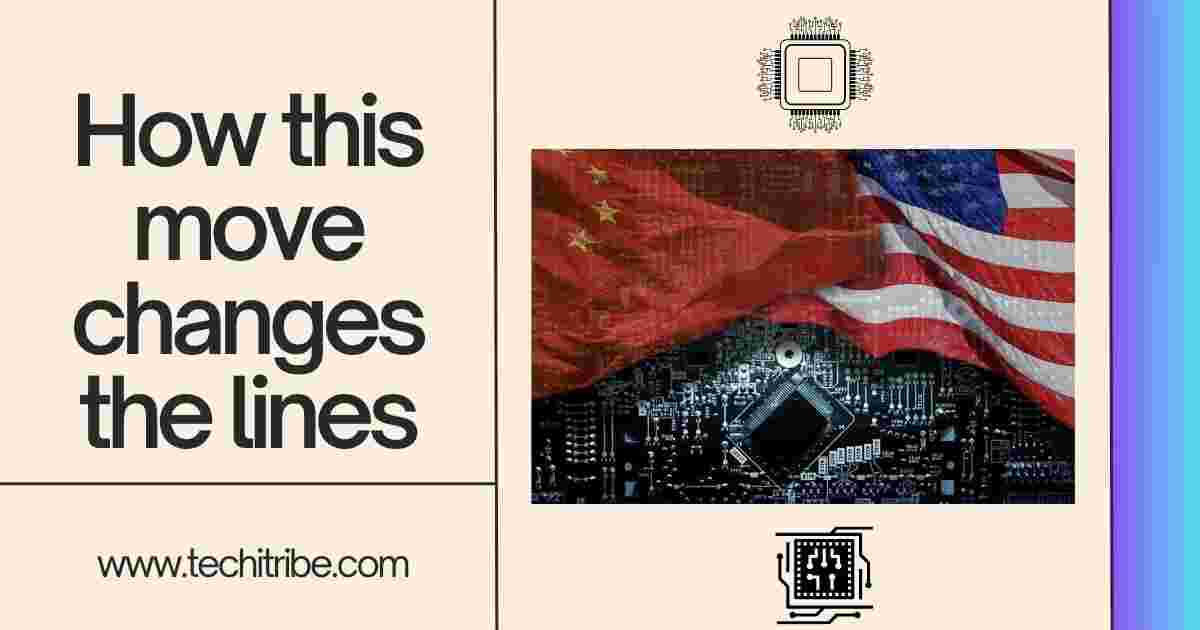US-China Semiconductor Restrictions, Perhaps at the very center of all technological advance, the semiconductor industry is the enabler of everything from smart-phones and electric cars to supercomputers and even sophisticated AI systems. And increasingly, this lifeblood of modern technology remains at the epicenter of the high-stakes game of high-tech warfare played out between the United States and China.
The tightening of controls over how China gains access to high-edge semiconductor manufacturing tools at its disposal marks the latest push from the United States for its pursuit to continue and remain well-positioned on the globe as regards the global high-tech race. Policy limits a set of otherwise accessible technologies in China’s hands; yet, the move stands pivotal since it aids US strategic interests worldwide in a given global supply chain – semiconductor.
What does that constraint imply? Well, really, what does that say for the future of this ecosystem of this tech? Alright, so let’s break that down further.
Also Visit On This Link: Mastering AI Content Detection: Why It Matters and How to Do It Right
![]()
The Strategic Importance of Semiconductor Tools
Why Tools are Important in Making Chips, US-China Semiconductor Restrictions,
US-China Semiconductor Restrictions, Indeed, semiconductors are the blood and juice of modern technology, but manufacturing semiconductor chips is by no means a child’s game. It actually represents a sophisticated web of highly specialized tools applied in lithography, deposition, and etching. This then makes possible the creation of chips studded with billions of teeny weeny transistors-all that is necessary for high-performance computing and truly advanced applications.
These are identified US critical choke points in the semiconductor supply chain. Therefore, with this restriction in access to China, the US slows its adversary’s capability in the setup of leading-edge chips. The installation of leading-edge chips has high requirements for power since these are required to support leading artificial intelligence, 5G networks, and state-of-the-art military systems, meaning that control over semiconductor tools has much importance for national security.
Market Major Players
Top-notch world leaders in semiconductor tool-making companies are:
US-China Semiconductor Restrictions, ASML (Netherlands) Stakes its claim in a leading supplier of extreme ultraviolet lithography machines that actually write transistors inside a chip Applied Materials (US): This sells solutions involving material engineering applied to semiconductors.
Lam Research (US): US-China Semiconductor Restrictions, These firms do studies on deposition and etching technologies which are the majority parts of the main chip production. That puts the firm smack into the center of top-level chip making, and its equipment remains a potent arsenal in the world technological combat.
New Prohibitive Steps
What US has created
US-China Semiconductor Restrictions, Now the US government has strictly controlled the export of equipment for manufacturing semiconductors and covered a broader semiconductor manufacturing tool. The toolmakers based in the United States, as well as international peers of the US toolmakers, are subjected to licensure before they can sell those high-end equipment pieces to Chinese companies.
.
Constraints imposed include:
EUV Lithography Machines: Those needed to fabricate a chip at or below the 7nm process node for AI and high-speed computing applications.
Etching and Deposition Equipment: Those needed to materialize the layers of complexity on which a modern chip is made.
In this manner, the US has left out only China from the tool kit to bar the production of cutting-edge chips.

How this move changes the lines
Not an opening game, but an important game move. Last summer, the United States also banned Huawei, one of China’s technological leaders; Nvidia’s sales of chips carrying AI-related capabilities also suffered. Those rounds sink in even deeper: machinery and equipment to make a production leap forward.
This will give a message towards a new orientation. The approach will no longer be product by product but on this foundational structure of the semiconductor business.
Impact on China Integrated Circuit Industry
Inflationary and Stagflation of Chinese Producers
US-China Semiconductor Restrictions, The companies- especially, the leaders in this industry including Semiconductor Manufacturing International Corporation, a short form for SMIC– suffer through being squeezed by Chinese IC producers. It is really not easy for such companies to perform or compete globally due to lack of expensive tools.
It is one of the decades China has spent in a self-sustaining effort to build an intrinsically independent semiconductor ecosystem. The country has already spent billions of dollars in indigenous R&D and manufacturing. The curbs could, however, scuttle just this kind of effort by limiting access to the country’s future access to next-generation technologies that produce future-advanced chips.
Step further into self-reliance
US-China Semiconductor Restrictions, That is the light in which the wake of a series of US moves has prompted China to step up efforts in self-reliance in technology. The promise is huge investments in the country’s semiconductor industry, focusing on building homegrown alternatives to imported overseas equipment.
While recent progress has been fantastic, particularly for the leaders in leading-edge logic chips, the gap for the best capability now is enormously large. Citing back on par with technology in front-runners, such as Taiwan’s TSMC or South Korea’s Samsung, takes years and much more difficult without key tools.
Deeper Relevance to the International Technology Infrastructure
Barriers to Non-US Tool Manufacturers
US-China Semiconductor Restrictions, All which keeps the non-American tool makers in a corner, as found in companies such as ASML, and also that its US outside positioning remains reliant on the US source of technology and market into which they will be subjected and to have new terms imposed.
This is a precarious situation wherein the international players have to now balance their China-oriented business interest with their interest above and beyond in the US, both in terms of technology availability as well as in terms of market access.
Supply Chain Disruptions
US-China Semiconductor Restrictions, Indeed, the semiconductor industry is a very interdependent supply chain of the globe. Cutting access to China with these tools may result in several unintended consequences such as delay, increased cost, and shortages of supply.
For example, most of the technology-making companies rely on Chinese manufacturing to assemble their products. Some of the industries involved are consumer electronics, automotive productions among others. This is thus weaknesses in areas affecting all do to with them.

Geopolitics
A War for Technological Supremacy
US-China Semiconductor Restrictions, Not in the new restrictions on tools being placed by the United States on semiconductors for China is it anything so shallow as some form of so-called chip interest. Much deeper is this: global leadership, at least for a foreseeable future, in technology. The very heart of all these new high-speed, emerging technologies–AI and quantum computers, which rely so crucially on high-performance computing–are semiconductor structures that make up critical parts. They also represent an enabling key to the achievement of an autonomous vehicle. Control of production therefore amounts to strategic momentum.
This makes the strategy of the United States in trying to ensure that the country holds the technological edge but meanwhile denies that of the nation of China, giving them a possibility of emerging to be super powers in that critical areas of the countries. This raises the likelihood of increasing the gap between these two nations and which leads to fragmentation in the global tech ecosystem.
The Risks of Escalation
US-China Semiconductor Restrictions, This step by the US no doubt will cripple China’s stride in the near term, yet it still carries risks: Denying China access to some of those key technologies may, inadvertently perhaps, spur Beijing to redouble its efforts on developing indigenous alternatives.
This would give rise to two distinct tech ecosystems-the one led by the US and its partners, and the other one led by China. This would raise costs and complications for business around the world while it would cause an inconvenience to global cooperation in cyber security, climate, etc.
Opportunity and Trouble at the Heart: Innovating in Adversity
US-China Semiconductor Restrictions, Anyway, this way, there still exists the chance somehow to release some part of that situation there as China is flooding with billions and billions dollars into tool-making machinery of semiconductors capable of creating ground for the revolutionary break-through to upset the equilibrium established until this very point.
USA, along with its allies, plans to pump additional investments into research and development in the sphere of semiconductors, though not for the sake of lagging behind the wave of the new technological shift.
Integration of Partnerships
US-China Semiconductor Restrictions, The US, with such emphasis, has also integrated international cohesiveness to the quest. The US allied itself with Japan and South Korea and the Netherlands against technological aggression by China.
Mutual relations would continue to be a defining feature for dictating the future of semiconductors around the world and technological supremacy in the possession of democracies.
Conclusion: Not That Glittery Either
Thus it would finally be the US that would tighten its noose around China’s access to semiconductor tools and in doing so, took this ever-present tech rivalry to another level. Kept, however, on an eye toward American leadership though these moves do point toward global stakes of high-tech racing.
The ride forward for China is bumpy while trying to outplay these obstructions and eventually succeed at full self-reliance. Innovation, cooperation, and being one step ahead will remain locked in the minds of the US and its allies in consideration of a fast-evolving landscape.
It is a watershed for the semiconductor industry, and what decisions are made today shall have implications for the kind of future technology will have for many years to come: collaboration and shared progress or division and competition-only time will tell.
👍